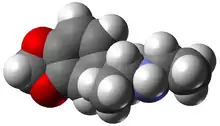 | |
 | |
| Clinical data | |
|---|---|
| Other names | MDEA, MDE, Eve |
| Routes of administration | Oral, insufflation, injection, rectal[1] |
| ATC code |
|
| Legal status | |
| Legal status |
|
| Pharmacokinetic data | |
| Metabolism | Hepatic including CYP2D6 and CYP3A4 |
| Onset of action | 20–85 minutes |
| Elimination half-life | (R)-MDEA: 7.5 ± 2.4 hours (S)-MDEA: 4.2 ± 1.4 hours |
| Excretion | Renal |
| Identifiers | |
| |
| CAS Number | |
| PubChem CID | |
| ChemSpider | |
| UNII | |
| KEGG | |
| ChEBI | |
| CompTox Dashboard (EPA) | |
| ECHA InfoCard | 100.231.031 |
| Chemical and physical data | |
| Formula | C12H17NO2 |
| Molar mass | 207.273 g·mol−1 |
| 3D model (JSmol) | |
| |
3,4-Methylenedioxy-N-ethylamphetamine (MDEA; also called MDE and colloquially, Eve) is an empathogenic psychoactive drug. MDEA is a substituted amphetamine and a substituted methylenedioxyphenethylamine. MDEA acts as a serotonin, norepinephrine, and dopamine releasing agent and reuptake inhibitor.[1]
Possession of MDEA is illegal in most countries. Some limited exceptions exist for scientific and medical research.
Uses
Medical
MDEA currently has no accepted medical uses.
Recreational
MDEA is used recreationally in a similar manner to MDMA (also called ecstasy), however the subjective effects of MDEA are milder and shorter lasting.[1][3] Alexander Shulgin reported it to be stoning in high doses.[4] Most frequently consumed orally, recreational doses of MDEA are in the range 100 to 200 mg. Infrequently, MDEA is an adulterant of ecstasy pills. Studies conducted in the 1990s found MDEA present in approximately four percent of ecstasy tablets.[1]
Adverse effects
Reported adverse effects from MDEA include the following:
Overdose
Reported overdose symptoms of MDEA include the following:
Chemistry
Synthesis
MDEA is typically synthesized from essential oils such as safrole or piperonal.
History, society, and culture
Alexander Shulgin conducted research on methylenedioxy compounds in the 1960s. In a 1967 lab notebook entry, Shulgin briefly mentioned a colleague's report of no effect from the substance with a 100 mg dose.[5] Shulgin later characterized the substance in his book PiHKAL.[4]
In the United States, MDEA was introduced recreationally in 1985 as a legal substitute to the newly banned MDMA.[3] MDEA was made a Schedule 1 substance in the United States on August 13, 1987, under the Federal Analog Act.[1]
See also
References
- 1 2 3 4 5 6 Freudenmann RW, Spitzer M (2004). "The Neuropsychopharmacology and Toxicology of 3,4-methylenedioxy-N-ethyl-amphetamine (MDEA)". CNS Drug Reviews. 10 (2): 89–116. doi:10.1111/j.1527-3458.2004.tb00007.x. PMC 6741736. PMID 15179441.
- ↑ Anvisa (2023-07-24). "RDC Nº 804 - Listas de Substâncias Entorpecentes, Psicotrópicas, Precursoras e Outras sob Controle Especial" [Collegiate Board Resolution No. 804 - Lists of Narcotic, Psychotropic, Precursor, and Other Substances under Special Control] (in Brazilian Portuguese). Diário Oficial da União (published 2023-07-25). Archived from the original on 2023-08-27. Retrieved 2023-08-27.
- 1 2 3 4 5 6 7 8 9 10 11 Tehan B, Hardern R, Bodenham A (June 1993). "Hyperthermia associated with 3,4-methylenedioxyethamphetamine ('Eve')". Anaesthesia. 48 (6): 507–10. doi:10.1111/j.1365-2044.1993.tb07072.x. PMID 8322992. S2CID 40356638.
- 1 2 Shulgin A. "#106 MDE: MDEA; EVE; N-Ethyl-MDA; 3,4-Methylenedioxy-N-ethylamphetamine". Isomer Design. Retrieved 10 December 2014.
- ↑ Benzenhöfer U, Passie T (August 2010). "Rediscovering MDMA (ecstasy): the role of the American chemist Alexander T. Shulgin". Addiction. 105 (8): 1355–61. doi:10.1111/j.1360-0443.2010.02948.x. PMID 20653618.
